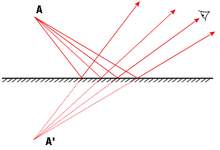Plane mirror


A plane mirror is a mirror with a flat (planar) reflective surface.[1][2] For light rays striking a plane mirror, the angle of reflection equals the angle of incidence.[3] The angle of the incidence is the angle between the incident ray and the surface normal (an imaginary line perpendicular to the surface). Therefore, the angle of reflection is the angle between the reflected ray and the normal and a collimated beam of light does not spread out after reflection from a plane mirror, except for diffraction effects.
A plane mirror makes an image of objects in front of it; these images appear to be behind the plane in which the mirror lies. A straight line drawn from part of an object to the corresponding part of its image makes a right angle with, and is bisected by, the surface of the plane mirror. The image formed by a plane mirror is always virtual (meaning that the light rays do not actually come from the image), upright, and of the same shape and size as the object it is reflecting. A virtual image is a copy of an object formed at the location from which the light rays appear to come. However, the image is a laterally-inverted "mirror image" of the object. If a person is reflected in a plane mirror, the image of his right hand appears to be the left hand of the image.
Plane mirrors are the only type of mirror for which a real object always produces an image that is virtual, erect and of the same size as the object. Virtual objects produce real images, however. The focal length of a plane mirror is infinity;[4] its optical power is zero.
Preparation

A plane mirror is made using some highly reflecting and polished surface such as a silver or aluminum surface in a process called silvering.[5] After silvering, a thin layer of red lead oxide is applied at the back of the mirror. The reflecting surface reflects most of the light striking it as long as the surface a remains uncontaminated by tarnishing or oxidation. Most modern plane mirrors are designed with a thin piece of plate glass that protects and strengthens the mirror surface and helps prevent tarnishing. Historically, mirrors were simply flat pieces of polished copper, obsidian, brass, or a precious metal. Mirrors made from liquid also exist, as the elements gallium and mercury are both highly reflective in their liquid state.
Relation to curved mirrors
Mathematically, a plane mirror can be considered to be the limit of either a concave or a convex spherical curved mirror as the radius, and therefore the focal length, becomes infinite.[4] If we cut a spherical mirror in to small parts, then the focus of the small parts will not change because their center of curvature will not change. Now small parts are cut into much smaller parts and their focus will also remain same as of later one's. very much small part can act as a plain mirror and its focus will also be the same. Then why the focus of plain mirror is infinite
See also
References
- ↑ Moulton, Glen E. (April 2013). CliffsNotes Praxis II: Middle School Science (0439). Houghton Mifflin Harcourt. ISBN 1118163974.
- ↑ Saha, Swapan K. (2007). Diffraction-Limited Imaging with Large and Moderate Telescopes. World Scientific. ISBN 9789812708885.
- ↑ Giordano, Nicholas (2012-01-01). College Physics. Cengage Learning. ISBN 1111570981.
- 1 2 Katz, Debora M. (2016-01-01). Physics for Scientists and Engineers: Foundations and Connections. Cengage Learning. ISBN 9781337026369.
- ↑ Kołakowski, Leszek (September 2000). Science and Technology Encyclopedia. University of Chicago Press. ISBN 9780226742670.